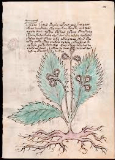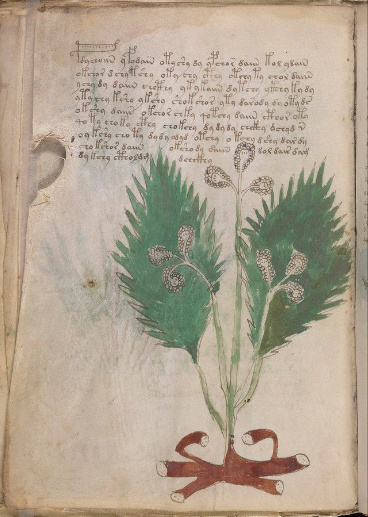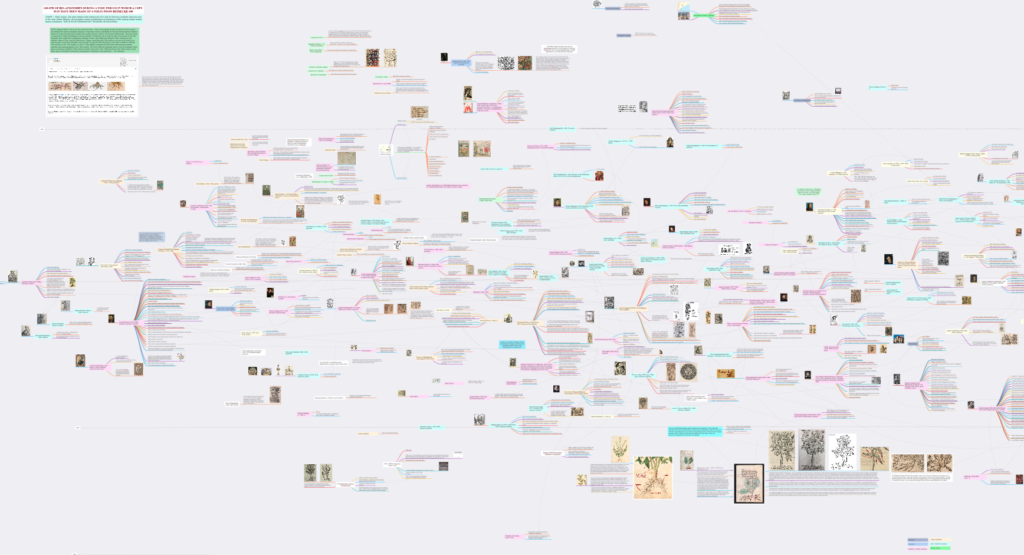28 April 2021

More than five years, ago Fabrizio Salani purchased a drawing at a second-hand market in Italy that resembles a copy of a VMS plant, folio 14v. Rene Zandbergen provided a link to the drawing on the voynich.ninja forum. Unfortunately, the link is no longer active, but Salani later posted an interesting video about his discovery on youtube that is still available.
Deja Vu
When I saw the drawing, I immediately noticed something familiar, something I had noticed while cruising through plant drawings, but I couldn’t remember where I had seen it. From that moment on, I was intrigued by the possibility of finding the illustrator and, after an extensive survey of medieval, Renaissance, and modern plant books, I located examples that have the same idiosyncrasies as the drawing purchased by Salani.
The Long Road Forward

The only reason it was possible to find the Salani illustrator is because he substituted his own style of root for the VMS root. The VMS drawing (right) has a crab-like root, painted a dark brick-red). The Salani root is more naturalistic. He also added an extra leaf which has some distinctive properties.
At the time we were alerted to the Salani drawing, I posted a few examples of roots on the voynich.ninja forum (02/12/16). I knew they were not the same illustrator, but I had a feeling they they might be approximately the same time period. I did not restrict my search to this period of history, however, but several years of research brought me back to it, time and time again, and it turned out to be the right ballpark.
The Salani drawing is not a slavish copy of the VMS plant, but it’s faithful enough that it cannot be a coincidence. Assuming the Salani illustrator copied the VMS (or copied a copy of the VMS) and not the other way around (which seems unlikely), he apparently did not think a 100% faithful copy was needed for whatever purpose he made the copy.
Voynichese Characters
The VMS glyphs are not copied with complete accuracy either. They are mostly right, and even the way they cross the leaf has been honored, but there are some small discrepancies.
Guessing at the purpose of the copy is difficult, but my research on printing history revealed that Renaissance entrepreneurs scrambled to gather up manuscripts that they could turn into printed books. Perhaps there was a period in the life of the VMS when someone thought it might be worthy of print reproduction. If so, this may have occurred during the “dark” portion of the VMS provenance.
Another possibility is that the copy represents one of the events documented in letters about the VMS between the Jesuits who had it in their possession before Wilfrid Voynich acquired it. There is mention of a copy (the current owner apparently didn’t want to give up the whole manuscript). I will discuss this in future posts because this is only valid if the active life of the illustrator synchs up with the dates of the letters.
Summary
I will share more about this intriguing discovery in future blogs, but for now, here is a small portion of a chart I created as I was searching for the illustrator and, more importantly searching for corroborating evidence to pinpoint the dates during which he was active and who he associated with at the time.

I will post close-ups at a future date (this is a teaser since it’s not possible to explain the whole chart without close-ups that show the connections).
J.K. Petersen
© Copyright April 2021 J.K. Petersen, All Rights Reserved

Very interesting, I look forward to seeing what you found out! :+)
I wish I could see anything on your chart! It looks exhaustive, complicated and well-researched as always though.
I’m sure this has nothing to do with it, but I do find it weird the copyist has used some of the weird conventions the original Voynich illustrator possibly used: the addition of the leaf and the different roots.
For instance, regarding extra or less components: on the Rosettes page, we have 37 moons when there should be 36, 13 spokes for the zodiac when there should be 12, 15 words for the spiral when there should, I think, be 14 , whereas below, if the cosmos is the cosmos, it has 6 temples, but the number should be 7 to represent the meeting of heaven and earth, and in the vegetabilis frame middle bottom, there should be 6 not 7 petals/spokes, as plants had an established number of parts, just as the zodiac did. The VMS author, to me, messes with the numerical symbolism by either adding or subtracting a “1”. It happens too often, always with “1” as the difference, to be a coincidence.
Re the roots, someone has already said somewhere that roots on the Voynich don’t match the plants. But this too might be a repeating motif in my interpretation. The bottom row of the Rosettes is cthonic, based on Greek myth, whereas the top row is Judeo-Christian. A dysjunction between top and bottom, “flowers” and “roots”. And there’s an illustration in the bath section that seems to explicitly show an evolution, or progression of religious ‘bodies’, from pantheistic Egyptian animal gods, to Greek, to Jewish to Christian. Once again, the “roots” don’t match the stems and “flowers”.
Regardless if you accept my interpretation, which I would have to exhaustively detail so won’t, and likely frame in apophatic theology and/or the Aristotelian empymeme, I find it very interesting that these two recurring motifs I have identified have been used by this illustrator when making his/her own copy.
It implies he or she was aware of them, when I’ve never seen them mentioned as a recurring motif (though that means nothing, as I’ve never read early interpretations, just D’Imperio’s selection), and for some reason has deliberately used them when copying from one to another.
Anyway, throwing that out in case somewhere along the line it contributes to your research, which I still have no idea about! But the idea you could find another, concrete piece of the puzzle is incredibly exciting! Well done, and best of luck writing it up!
Another thing: I followed the link on Ninja and found the original post. Honestly, this is amazing.
I did wonder whether the A G seal impression, with G centered in the middle of the A, might be a stylized or personalized Masonic symbol, so have asked the Freemason museum just to rule it out. Don’t know if they’ll reply.
Dear Mr. Petersen,
I am Fabrizio Salani, I apologize for writing to you just now, but I only found out a few days ago about your research on the parchment in my possession and first of all, many thanks for your time and research about the parchment I have found. If you think I can help you with your research, I can send you the high resolution scans of the parchment in my possession and the results of the Raman spectroscopy that I had made by the physics laboratories of the University of Modena and Reggio Emilia (UNIMORE), the university that carried out the same studies on the Borso d’Este’s Bible (1455-1461).
Remaining at your disposal for any other info, thank you again and best regards.
Fabrizio Salani
Fabrizio Salani, I sincerely apologize that it has taken me so long to reply to you. I have been away from my blog for almost two years, involved with important business concerning our national elections and have not had an opportunity to read comments until today.
I have not had even one hour to work on the Voynich Manuscript for far too long, but I have a great deal of research on your Voynich drawing and I think you will be excited to see what I have found.
Thank you for dropping by my blog. I would be very happy to see high resolution scans and the results of the research and also to share with you what I have found, which is important to the timeline of your drawing and Voynich research in general.
Let me know how we can communicate. Email is best for me since I have files I need to transmit to show you what I have uncovered.